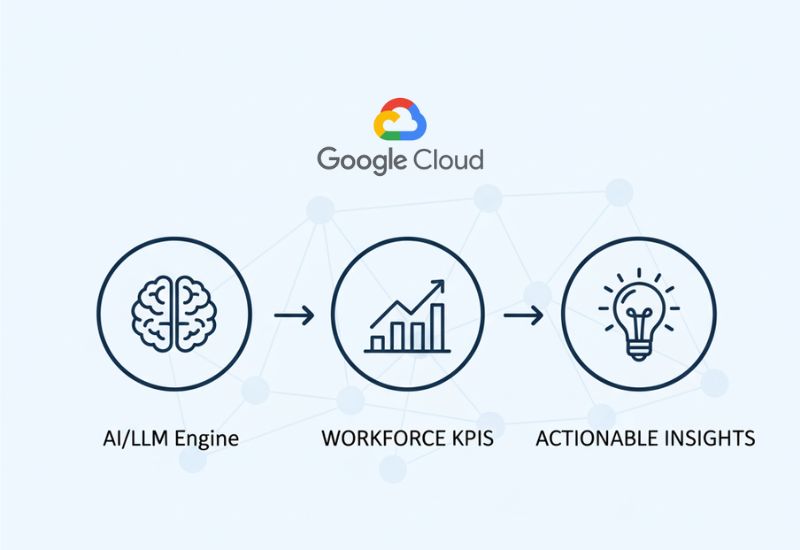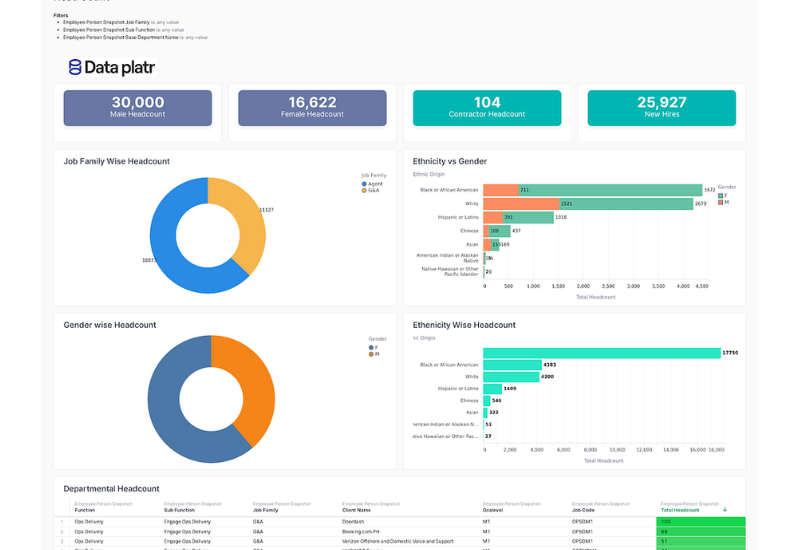What is Data Mesh?
Data Mesh is a modern approach to data architecture that helps organizations scale data and analytics across business domains. Rather than centralizing all data into a single data lake or warehouse, it enables teams to own and manage their own data as a product, supported by shared platforms and governed by standardized policies.
How Does a Data Mesh Work?
Data Mesh operates on the core principle that data should be treated as a product and owned by the teams that generate and use it. Rather than funneling all data into a centralized system for processing, this approach decentralizes data ownership to individual business domains, such as marketing, sales, or operations, also allowing them to manage their own data pipelines and outputs.
The architecture is built around domain oriented data ownership, where each team is accountable for the quality, accessibility, and usability of its own data. A self-serve data platform supports this decentralized model by providing the tools and infrastructure needed to publish and consume data products efficiently. The philosophy of product thinking is applied to data assets, ensuring they are well documented, reliable, and customized to user needs. To tie everything together, federated governance is implemented to maintain consistency, compliance, and interoperability across domains without reverting to centralized control. This model ensures that data remains discoverable, trustworthy, and usable at the point of creation and also empowering organizations to scale data practices organically and efficiently.
How to Implement Data Mesh
Implementing requires more than new tools. It demands a mindset shift and organizational alignment. Here's a high-level framework for getting started:
- Identify Domains - Map your organization’s business domains and align data responsibilities accordingly.
- Assign Data Product Owners - Designate leaders within each domain to manage the lifecycle, quality, and accessibility of their data products.
- Build a Self-Serve Data Platform - Develop platform capabilities that allow teams to manage data pipelines, metadata, lineage, and security without centralized bottlenecks.
- Establish Federated Governance - Create standards and policies that support compliance and interoperability across domains.
- Promote a Data Product Culture - Encourage teams to treat data as a product and also prioritize usability, documentation, quality, and accessibility.
At Dataplatr, we provide strategic guidance and platform support to help businesses shift the Data Mesh model with confidence.
Real-World Casestudy: Saxo Bank’s Data Mesh Transformation
Saxo Bank collaborated with Thoughtworks to implement a data meshing architecture. By decentralizing their data ownership and building a “data workbench,” they enabled domain teams to create searchable and discoverable data assets.
Key Outcomes:
- Lowered customer acquisition costs
- Improved data transparency and compliance
- Enabled faster, decentralized access to trusted data
This case highlights how applying data mesh principles such as treating data as a product and embracing federated governance also can create real business value.
Benefits of a Data Mesh
Data Democratization - It enables self service access to data across various business domains, allowing non technical users like analysts and product teams to access and work with data independently. By decentralizing ownership and making data more discoverable, it reduces reliance on central IT or data engineering teams. This fosters faster decision-making and empowers more people to act on insights.
Cost Efficiency - A distributed data architecture leverages cloud-native platforms and streaming technologies for real-time data collection and processing. This approach avoids expensive batch processing and allows dynamic scaling. Organizations only pay for what they use. As a result, teams can better manage storage and compute costs while delivering timely insights.
Reduced Technical Debt - Centralized data systems often become complex and fragile over time, increasing the burden on engineering teams. It reduces this strain by distributing responsibilities, allowing each domain to maintain its own pipelines. With fewer dependencies, teams can build modular, scalable solutions and avoid system slowdowns and maintenance overload.
Interoperability and Standardization - It encourages domains to agree on standardized formats for shared data, including schema, metadata, and field definitions. This uniformity improves cross-domain collaboration and ensures different datasets can be integrated seamlessly. Standardization makes APIs easier to develop and consume, accelerating application development.
Stronger Security and Compliance - With federated governance built into the architecture, It ensures robust security policies and access controls across domains. Sensitive data can be properly managed with audit trails, usage logs, and granular permissions. This structure supports regulatory compliance, such as GDPR or HIPAA, by embedding observability and accountability into the system.
Increased Agility and Innovation - By decentralizing data ownership and reducing bottlenecks, teams can innovate faster. They can develop and deploy domain-specific data products tailored to their users’ needs without waiting on centralized resources. This accelerates experimentation and responsiveness, allowing businesses to adapt quickly to market changes.
What Challenges Does a Data Mesh Solve?
- Centralized Bottlenecks - Traditional architectures rely heavily on central data teams, creating delays and capacity issues.
How It Solves: By distributing data ownership to domain teams, each unit can manage its own pipelines and workflows, reducing dependency on a central bottleneck. - Siloed Data Ownership - Data often resides in isolated systems across departments, making integration and access difficult.
How It Solves: It encourages a culture of shared responsibility, where domains publish accessible and interoperable data products. - Long Development Cycles - Centralized coordination slows down analytics and data product delivery.
How It Solves: Decentralized ownership allows multiple teams to build and iterate on data products in parallel, drastically accelerating timelines. - Poor Data Discoverability - Users struggle to find, understand, or trust available data in traditional systems.
How It Solves: With enforced metadata standards and product thinking, data becomes more visible, well-documented, and easier to navigate.
5. Data Quality Issues - When responsibility is unclear, data quality suffers and trust in analytics declines.
How It Solves: Each domain is responsible for the quality and reliability of its data, ensuring accountability and consistent standards.
Data Mesh vs Data Fabric
A Data Fabric is a modern data architecture designed to simplify and automate data integration across hybrid and multi-cloud environments. It acts as an intelligent layer over existing infrastructure, using technologies like AI and metadata management to unify data access, improve visibility, and support real-time data sharing. Think of it as the connective tissue that links diverse systems without requiring major changes to how data is stored or processed.
Data Mesh is more about rearranging your data operating model. It decentralizes data ownership by assigning responsibility to domain teams, who treat data as a product and manage it end-to-end. Instead of routing all data through a central platform, also it enables each business domain to own, publish, and consume its own data, supported by shared infrastructure and governance standards.
While both architectures aim to improve data accessibility and usability, their approaches are fundamentally different. A Data Fabric works with your existing infrastructure, integrating and automating data flows. A Data Meshing requires a shift in organizational structure and process, distributing ownership and transforming how data is produced and consumed across the company.
Ultimately, they’re not mutually exclusive. Data Fabric enables connectivity, while it enables scalability through autonomy. Together, they can complement each other to create a powerful, modern data strategy.
Data Mesh vs Data Lake
A Data Mesh is a modern, decentralized data architecture where data is treated as a product and managed by individual business domains. This design improves accessibility and ownership by empowering domain teams to publish, maintain, and serve their data directly to consumers across the organization.
Data Lake is a centralized storage system that collects vast volumes of structured, semi-structured, and unstructured data. Also, it’s often without a clearly defined purpose at the time of ingestion. It's designed to store raw data at scale for use in analytics, AI ML, and reporting.
While a Data Lake can be part of a strategy, the two serve different roles. A data lake typically acts as a passive data repository. Without proper governance and purpose, it can easily become a data swamp, where low-quality or inaccessible data accumulates. On the other hand, Data Meshing introduces active ownership, governance, and discoverability also turning raw data into high-value, curated assets aligned with business needs.
In short, a Data Lake is about storage, while Data Meshing is about structure, ownership, and usability.
What is Data Mesh Architecture and its Principles?
Data mesh architecture is a modern, decentralized approach to managing data across large organizations. It breaks away from the traditional monolithic data lake or warehouse model and instead promotes domain-oriented ownership, where each business function manages its own data as a product. This architectural shift is supported by four key principles:
1. Domain-Oriented Decentralized Ownership
Data responsibilities are distributed across domain teams. like sales and marketing or finance also who produce and manage the data they know best. This reduces bottlenecks caused by centralized data teams and ensures that data stays close to the business context.
2. Data as a Product
Each data set is treated as a product with clear ownership, quality standards, and usability goals. Domain teams must ensure that their data products are discoverable, trustworthy, well-documented, and reliable also just like customer-facing products.
3. Self-Serve Data Infrastructure
To support decentralized data ownership, organizations must build a self-serve platform that provides the tools, pipelines, and capabilities domain teams need to publish, access, and use data independently, without constant reliance on central IT.
4. Federated Computational Governance
Data governance in a mesh is not fully centralized, it’s a hybrid. While global standards for security, quality, and compliance are defined centrally, domain teams have autonomy to implement and enforce those standards locally, ensuring consistency without losing agility.
Conclusion
Data mesh isn’t just a buzzword, it’s a transformative approach that aligns data management with business domains, achieving faster insights, scalable architecture, and true data democratization. By following core data mesh principles like domain ownership, treating data as a product, self-serve infrastructure, and governance.
This new way of working with data, known as data meshing, helps teams find and use reliable data more quickly, make smarter decisions, and grow without running into delays or data blocks.
Ready to modernize your data strategy with a data mesh approach?
Let Dataplatr help you build a modern and easy-to-manage data system that grows with your business.



























